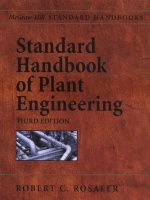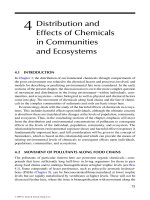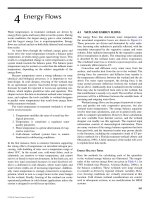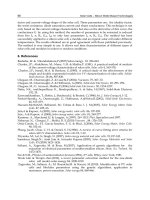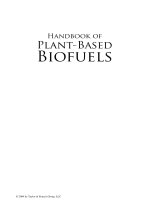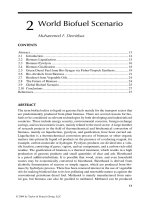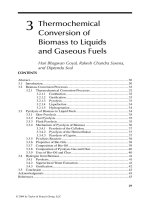Handbook of plant based biofuels - Chapter 4 pot
Bạn đang xem bản rút gọn của tài liệu. Xem và tải ngay bản đầy đủ của tài liệu tại đây (333.22 KB, 10 trang )
45
4
Production of Biofuels
with Special Emphasis
on Biodiesel
Ayhan Demirbas
ABSTRACT
Biodiesel, an alternative biodegradable diesel fuel, is a renewable fuel that can be pro-
duced from vegetable oils, animal fats, and used cooking oil, including triglycerides.
It is derived from triglycerides by transesterication with methanol and ethanol. Con-
cerns about the depletion of diesel fuel reserves and the pollution caused by the con-
tinuously increasing energy demands make biodiesel an attractive alternative motor
fuel for compression ignition engines. There are four different ways of modifying
vegetable oils and fats to use them as diesel fuel, such as pyrolysis/cracking, dilution
with hydrocarbons blending, emulsication, and transesterication. The most com-
monly used process is the transesterication of vegetable oils and animal fats.
4.1 INTRODUCTION
The term biofuel generally refers to liquid or gaseous fuels for the transport sec-
tor that are predominantly produced from biomass. Biomass (all plants and living
organisms) can be converted into liquid and gaseous fuels through thermochemical
CONTENTS
Abstract 45
4.1 Introduction 45
4.2 Vegetable Oils as Diesel Fuels 46
4.3 Biodiesel 47
4.4 Noncatalytic Transesterication with Supercritical Alcohol
Transesterication 49
4.5 Transesterication Reaction Mechanism of Vegetable Oil 50
4.6 Variables Affecting Methyl Ester Yield 51
4.7 Comparison of Fuel Properties andCombustion Characteristics of
Methyl and Ethyl Alcohols and Their Esters 52
4.8 Biodiesel Economy 53
4.9 Conclusions and Future Perspectives 53
References 53
© 2009 by Taylor & Francis Group, LLC
46 Handbook of Plant-Based Biofuels
and biological routes. Biofuel is a nonpolluting, locally available, accessible, sustain-
able, and reliable fuel obtained from renewable sources. The liquid biofuels being
considered the world-over fall into the following categories: (1) vegetable oils and
biodiesels, (2) alcohols, and (3) biocrude and synthetic oils (Demirbas 2006). Fig-
ure 4.1 shows the resources of the main liquid biofuels for automotives. Figure 4.2
shows the main biomass conversion processes.
4.2 VEGETABLE OILS AS DIESEL FUELS
The use of vegetable oils as alternative renewable fuel competing with petroleum
was proposed at the beginning of the 1980s. The advantages of vegetable oils as die-
sel fuel are their liquid nature, which implies portability, ready availability, renew-
ability, higher heat content (about 88% of No. 2 petroleum diesel fuel), lower sulfur
content, lower aromatic content, and biodegradability. A sustainable biofuel has two
favorable properties, which are availability from renewable raw material and lower
negative environmental impact than that of the fossil fuels. As an alternative fuel,
vegetable oil is one of the renewable fuels. Vegetable and animal oils/fats, which
Biofuels
Biodiesel
Bioethanol
Rapeseed Soybean Palm Sunflower
Wheat
Maize Sugar Beet Potatoes
FIGURE 4.1 Resources of main liquid biofuels for automotives.
Biomass Conversion
Feedstock
ermochemical Conversion
Biochemical Conversion
Pyrolysis Gasification Liquefaction Bioethanol Biodiesel
Syn-oil Syn-gas Bio-chemicals
FIGURE 4.2 Main biomass conversion processes.
© 2009 by Taylor & Francis Group, LLC
Production of Biofuels with Special Emphasis on Biodiesel 47
mainly consist of the triglyceride of the straight chain fatty acid, are organic chem-
icals made from carbon dioxide and water using solar energy. Vegetable oil is a
potentially inexhaustible source of energy, with an energy content close to that of
diesel fuel. Vegetable oils, such as palm, soybean, sunower, peanut, and olive oils,
can be used as alternative fuels for diesel engines. Vegetable oils used as alternative
engine fuels are all extremely viscous, with viscosities ranging from 10 to 20 times
higher than petroleum diesel fuel. The major problem associated with the use of pure
vegetable oils as fuels for diesel engines is caused by the high fuel viscosity in com-
pression ignition engines. The vegetable oils pose many problems when used directly
in diesel engines. These include (1) coking and trumpet formation on the injectors, to
such an extent that fuel atomization does not occur properly or even is prevented as
a result of plugged orices; (2) carbon deposits; (3) oil ring sticking; (4) thickening
or gelling of the lubricating oil as a result of contamination by vegetable oils; and (5)
lubricating problems.
There are different ways of modifying vegetable oils and fats to use them as
diesel fuel, and such methods as pyrolysis, dilution with hydrocarbons, and emulsi-
cation have been considered. Figure 4.3 shows the use of vegetable oils as petroleum
alternative fuels (Demirbas 2003). Emulsication with alcohols has been proposed
to overcome the problem of high viscosity of vegetable oils (Madras, Kolluru, and
Kumar 2004).
4.3 BIODIESEL
The diesel made from oils/fats has been noted as an ecological fuel because the oils/
fats are a sustainable energy resource. Thus, alkyl esters of fatty acids that meet
transportation fuel standards are called “biodiesel.” It has been also dened as the
monoalkyl esters of the long chain fatty acids derived from renewable feedstocks,
such as vegetable oils or animal fats, for use in compression ignition (diesel) engines.
Biodiesel has become more attractive because of its environmental benets and the
fact that it is made from renewable resources (Ma and Hanna 1999).
One popular process for producing biodiesel from the fats/oils is trans-ester-
ication of triglyceride by methanol (methanolysis) to make methyl esters of the
straight chain fatty acid. Alcohols are primary or secondary monohydric aliphatic
alcohols having one to eight carbon atoms. Among the alcohols that can be used in
the transesterication reaction are methanol, ethanol, propanol, butanol, and amyl
alcohol. Methanol and ethanol are used most frequently; ethanol is a preferred alco-
hol in the transesterication process compared to methanol because it is derived
Vegetable Oils
Direct
Use
Conversion to Biodiesel
by Alcoholysis
Conversion to Hydrocarbons
by Decarboxylation
Dilution with
Hydrocarbons
FIGURE 4.3 Use of vegetable oils as petroleum alternative fuels.
© 2009 by Taylor & Francis Group, LLC
48 Handbook of Plant-Based Biofuels
from agricultural products and is renewable and biologically less objectionable in the
environment. However, methanol is preferred because of its low cost and its physical
and chemical advantages (polar and shortest chain alcohol).
Methyl, ethyl, 2-propyl, and butyl esters have been prepared from canola and lin-
seed oils through transesterication using KOH and/or sodium alkoxides as catalysts.
In addition, (m)ethyl esters were prepared from rapeseed and sunower oils using
the same catalysts. Today, biodiesel is made from a variety of natural oils. Important
among these are soybean oil and rapeseed oil. Rapeseed oil, a close cousin of canola
oil, dominates the growing biodiesel industry in Europe. In the United States, biod-
iesel is being made from soybean oil because more soybean oil is produced than all
other sources of fats and oil combined. There are many candidates for feedstocks,
including recycled cooking oils, animal fats, and a variety of other oilseed crops.
For the preparation of biodiesel using a catalytic method, the catalyst (KOH) is
dissolved into methanol by vigorous stirring in a small reactor. The oil is transferred
into the biodiesel reactor and then the catalyst/alcohol mixture is pumped into the
oil. The nal mixture is stirred vigorously for 2 h at 340 K at ambient pressure. A
successful transesterication reaction produces two liquid phases: ester and crude
glycerin. The crude glycerin, the heavier liquid, settles at the bottom after a few
hours of settling. The phase separation can be observed within 10 minutes and can
be complete within 2 h of the settling. Complete settling can take as long as 20 h.
After the settling is complete, water is added at the rate of 5.5%, v/v of the methyl
ester of oil and then stirred for 5 minutes and the glycerin is allowed to settle again.
Washing the ester is a two-step process, which is carried out with extreme care. A
water wash solution at the rate of 28% by volume of oil and 1 g of tannic acid per liter
of water is added to the ester and gently agitated. Air is carefully introduced into the
aqueous layer while simultaneously stirring very gently. This process is continued
until the ester layer becomes clear. After settling, the aqueous solution is drained and
water alone is added at 28% by volume of the oil for the nal washing (Demirbas
2002). Figure 4.4 shows the catalytic biodiesel production diagram.
The physical characteristics of the fatty acid (m)ethyl esters are very close to
those of diesel fuel and the process is relatively simple. Furthermore, the (m)ethyl
esters of the fatty acids can be burned directly in unmodied diesel engines, with
very low deposit formation. The methyl and ethyl esters prepared from a particular
vegetable oil have similar viscosities, cloud points, and pour points, whereas methyl,
ethyl, 2-propyl, and butyl esters derived from a particular vegetable oil have similar
gross heating values. However, their densities, which were 2 to 7% higher than those
Biodiesel
Methanol or Ethanol
Catalyst
Vegetable Oil
Transesterification Reactor Glycerin
FIGURE 4.4 Catalytic biodiesel production.
© 2009 by Taylor & Francis Group, LLC
Production of Biofuels with Special Emphasis on Biodiesel 49
of diesel fuels, statistically decreased in the order 2-propyl > ethyl > butyl esters. The
higher heating values of the biodiesel fuels, on a mass basis, are 9 to 13% lower than
No. 2 petroleum diesel. The viscosities of biodiesel fuels are twice that of No. 2 petro-
leum diesel. The cloud and pour points of No. 2 petroleum diesel are signicantly
lower than those of biodiesel fuels. The biodiesel fuels produced slightly lower power
and torque and higher fuel consumption than No. 2 petroleum diesel.
Biodiesel is an efcient, clean, 100% natural energy alternative to the petro-
leum fuels. Among the many advantages of biodiesel fuel include the following: it
is safe for use in all the conventional diesel engines; offers the same performance
and engine durability as petroleum diesel fuel; is nonammable and nontoxic; and
reduces tailpipe emissions, visible smoke, and noxious fumes and odors. It is better
than diesel fuel in terms of the sulfur content, ash point, aromatic content, and
biodegradability (Demirbas 2003). If biodiesel is valorized efciently for energy
purposes, it would benet the environment and the local population through job
creation, provision of modern energy carriers to rural communities, avoiding urban
migration and reduction of CO
2
and sulfur levels in the atmosphere.
4.4 NONCATALYTIC TRANSESTERIFICATION WITH
SUPERCRITICAL ALCOHOL TRANSESTERIFICATION
In the conventional transesterication of animal fats and vegetable oils for biodiesel
production, the free fatty acids and water always produce negative effects, since
the presence of the free fatty acids and the water causes soap formation, consumes
catalyst and reduces catalyst effectiveness, all of which result in a low conversion
(Komers, Machek, and Stloukal 2001). The transesterication reaction may be car-
ried out using either basic or acidic catalysts, but these processes are relatively time
consuming and require the complicated separation of the product and the catalyst,
which results in high production costs and energy consumption. In order to overcome
these problems, Saka and Kusdiana (2001) and Demirbas (2002, 2003) proposed that
biodiesel fuels may be prepared from vegetable oil via noncatalytic transesterica-
tion with supercritical methanol (SCM). The SCM is believed to solve the problems
associated with the two-phase nature of normal methanol/oil mixtures by forming a
single phase as a result of the lower value of the dielectric constant of the methanol
in the supercritical state. As a result, the reaction is completed in a very short time
(Han, Cao, and Zhang 2005). Compared with catalytic processes under barometric
pressure, the SCM process is noncatalytic, purication of the products is much sim-
pler, requires lower reaction time and lower energy, and is more environmentally
friendly. However, the reaction requires temperatures of 525 to 675 K and pressures
of 35 to 60 MPa (Demirbas 2003; Kusdiana and Saka 2001).
Supercritical transesterication is carried out in a high-pressure reactor (auto-
clave). In a typical run, the autoclave is charged with a given amount of the vegetable
oil and liquid methanol with changed molar ratios. The autoclave is supplied with
heat from an external heater, and the power is adjusted to give an approximate heat-
ing time of 15 min. The temperature of the reaction vessel can be measured with an
iron-constantan thermocouple and controlled at ±5 K for 30 min. The transesteri-
cation occurs during the heating period. After each run, the gas is vented, and the
© 2009 by Taylor & Francis Group, LLC
50 Handbook of Plant-Based Biofuels
autoclave is poured into a collecting vessel. All the contents are removed from the
autoclave by washing with methanol. Table 4.1 shows critical temperatures and criti-
cal pressures of various alcohols. Table 4.2 shows comparisons between the catalytic
methanol method and supercritical methanol method for the production of biodiesel
from vegetable oils by transesterication.
4.5 TRANSESTERIFICATION REACTION
MECHANISM OF VEGETABLE OIL
Transesterication consists of a number of consecutive, reversible reactions. The
triglyceride is converted stepwise to diglyceride, monoglyceride, and nally glyc-
erol. The formation of alkyl esters from monoglycerides is believed to be a step
that determines the reaction rate, because monoglycerides are the most stable inter-
mediate compound (Ma and Hanna 1999). Several aspects, including the type of
catalyst (alkaline, acid, or enzyme), alcohol to vegetable oil molar ratio, temperature,
water content, and free fatty acid content, have an inuence on the course of the
transesterication. In the transesterication of vegetable oils and fats for biodiesel
TABLE 4.2
Comparisons between the Catalytic Methanol (MeOH) method and
Supercritical Methanol (SCM) Method for the Production of Biodiesel from
Vegetable Oils by Transesterification
Method Catalytic MeOH Process SCM Method
Methylating agent Methanol Methanol
Catalyst Alkali (NaOH or KOH) None
Reaction temperature (K) 303–338 523–573
Reaction pressure (MPa) 0.1 10–25
Reaction time (min) 60–360 7–15
Methyl ester yield (wt%) 96 98
Removal for purication Methanol, catalyst, glycerol,
soaps
Methanol
Free fatty acids Saponied products Methyl esters, water
Smelling from exhaust Soap smelling Sweet smelling
TABLE 4.1
Critical Temperatures and Critical Pressures of Various Alcohols
Alcohol
Critical Temperature
(K)
Critical Pressure
(MPa)
Methanol 512.2 8.1
Ethanol 516.2 6.4
1-Propanol 537.2 5.1
1-Butanol 560.2 4.9
© 2009 by Taylor & Francis Group, LLC
Production of Biofuels with Special Emphasis on Biodiesel 51
production, free fatty acids and water always produce negative effects, as the pres-
ence of free fatty acids and water causes soap formation, consumes catalyst, and
reduces catalyst effectiveness, all of which result in a low conversion (Ali, Hanna,
and Cuppett 1995). The transesterication is an equilibrium reaction and the trans-
formation occurs essentially by mixing the reactants. In the transesterication of the
vegetable oils, a triglyceride reacts with an alcohol in the presence of a strong acid
or base, producing a mixture of fatty acids, alkyl esters, and glycerol. The stoichio-
metric reaction requires 1 mol of a triglyceride and 3 mol of the alcohol. However,
an excess of the alcohol is used to increase the yields of the alkyl esters and to allow
its phase separation from the glycerol formed (Bala 2005).
A reaction mechanism of the vegetable oil in the SCM was proposed based on
the mechanism developed by Krammer and Vogel (2000) for the hydrolysis of the
esters in sub- or supercritical water. The basic idea of supercritical treatment is the
effect of the pressure and temperature on the thermophysical properties of the sol-
vent, such as dielectric constant, viscosity, specic weight, and polarity (Kusdiana
and Saka, 2001).
4.6 VARIABLES AFFECTING METHYL ESTER YIELD
The most important variables affecting the methyl ester yield during the transesteri-
cation reaction are molar ratio of the alcohol to vegetable oil and the reaction tem-
perature. The viscosities of the methyl esters from the vegetable oils were slightly
higher than that of No. 2 diesel fuel. Figure 4.5 shows a typical example of the rela-
tionship between the reaction time and the temperature (Demirbas 2002). A hazelnut
kernel oil sample was used; the critical temperature and the critical pressure of meth-
anol were 512.4 K and 8.0 MPa, respectively. The variables affecting the ester yield
during the transesterication reaction were molar ratio of the alcohol to the vegetable
0
20
40
60
80
100
0 100 200 300400
Reaction Time (sec)
Yield of Methyl Ester, wt%
450 K
493 K
503 K
513 K
523 K
FIGURE 4.5 Changes in yield percentage of methyl esters as treated with subcritical and
supercritical methanol at different temperatures as a function of reaction time. Molar ratio of
vegetable oil to methyl alcohol: 1:41. Sample: hazelnut kernel oil.
© 2009 by Taylor & Francis Group, LLC
52 Handbook of Plant-Based Biofuels
oil, reaction temperature, reaction time, water content, and catalyst. It was observed
that increase in the reaction temperature, especially to supercritical temperatures,
had a favorable inuence on the ester conversion (Demirbas 2002). The stoichiomet-
ric ratio for the transesterication reaction requires three moles of alcohol and one
mole of triglyceride to yield three moles of fatty acid ester and one mole of glycerol.
Higher molar ratios result in higher ester production in a shorter time.
As has been mentioned above, in the catalyzed methods, the presence of water
has negative effects on yields of methyl esters. However, the presence of water posi-
tively affected the formation of methyl esters in our supercritical methanol method.
Figure 4.6 shows the plots for yields of methyl esters as a function of water content
in the transesterication of triglycerides.
Most diesel engines are designed to use highly lubricating, high sulfur content
fuel. Recent environmental legislature has forced diesel fuel to contain only a mini-
mum amount of the sulfur for lubricating purposes. Thus, the slightly higher viscos-
ity of biodiesel is helpful and lubricating to most diesel motors. Compared to No. 2
diesel fuel, all of the vegetable oils are much more viscous, much more reactive to
oxygen, and possess higher cloud point and pour point temperature. The ash point
of all vegetable oils is far above that of diesel fuel, reecting the nonvolatile nature
of the vegetable oils. Vegetable oils are not directly volatile, but crack during distil-
lation into a series of hydrocarbons or can be converted by transesterication into
more volatile methyl esters.
4.7 COMPARISON OF FUEL PROPERTIES AND
COMBUSTION CHARACTERISTICS OF METHYL
AND ETHYL ALCOHOLS AND THEIR ESTERS
In general, the physical and chemical properties and the performance of the ethyl
esters are comparable to those of the methyl esters. The methyl and ethyl esters have
almost the same heat content. The viscosities of the ethyl esters are slightly higher
and the cloud and pour points are slightly lower than those of the methyl esters.
0
012345
20
40
60
80
100
Water Content, %
Methyl Ester, %
Supercritical methanol Alkaline catalyst Acid catalyst
FIGURE 4.6 Plots for yields of methyl esters as a function of water content in transesteri-
cation of triglycerides.
© 2009 by Taylor & Francis Group, LLC
Production of Biofuels with Special Emphasis on Biodiesel 53
Engine tests demonstrate that methyl esters produce slightly higher power and torque
than the ethyl esters (Bala 2005). Some desirable attributes of the ethyl esters over
methyl esters are: they have signicantly lower smoke opacity, lower exhaust tem-
peratures, and lower pour point. The ethyl esters tend to have more injector coking
than the methyl esters.
4.8 BIODIESEL ECONOMY
The cost of the biodiesel fuels varies depending on the base stock, geographic area,
variability in the crop production from season to season, the price of the crude petro-
leum, and other factors. Biodiesel has over double the price of diesel. The high price
of biodiesel is largely due to the high price of the feedstock. However, biodiesel can
be made from other feedstocks, including beef tallow, pork lard, and yellow grease,
which are relative cheaper raw materials. Cooking oils can also be used as cheaper
raw materials. The problem with processing these low-cost oils and fats is that they
often contain large amounts of free fatty acids (FFA) that cannot be converted to
biodiesel using an alkaline catalyst.
A review of twelve economic feasibility studies shows that the projected costs
for biodiesel from oilseed or animal fats have a range of US$0.30 to $0.69/l, includ-
ing the meal and glycerin credits and the assumption of reduced capital investment
costs by having the crushing and/or esterication facility added onto an existing
grain or tallow facility. Rough projections of the cost of biodiesel from vegetable oil
and waste grease are US$0.54 to $0.62/l and US$0.34 to $0.42/l, respectively. With
pretax diesel priced at US$0.18/l in the United States and US$0.20 to $0.24/l in some
European countries, biodiesel is thus currently not economically feasible, and more
research and technological development are needed.
4.9 CONCLUSIONS AND FUTURE PERSPECTIVES
The biodiesels are the mono-alkyl esters of long chain fatty acids derived from
renewable feedstocks, such as vegetable oils or animal fats, for use in diesel engines.
The purpose of the transesterication of vegetable oils to their methyl esters is to
lower the viscosity of the oil. The main factors affecting transesterication are molar
ratio of glycerides to alcohol, catalyst, reaction temperature and pressure, reaction
time, and the contents of free fatty acids and water in oils.
Vegetable oils are a renewable and potentially inexhaustible source of energy,
with an energy content close to that of diesel fuel. The vegetable oil fuels are not
feasible because they are more expensive than petroleum fuels. However, with recent
increases in petroleum prices and the uncertainties concerning petroleum availabil-
ity, there is renewed interest in vegetable oil fuels for diesel engines.
REFERENCES
Ali, Y., M. A. Hanna, and S. L. Cuppett. 1995. Fuel properties of tallow and soybean oil
esters. JAOCS 72:1557–1564.
© 2009 by Taylor & Francis Group, LLC
54 Handbook of Plant-Based Biofuels
Bala, B. K. 2005. Studies on biodiesels from transformation of vegetable oils for diesel
engines. Energy Edu. Sci. Technol. 15:1–43.
Demirbas, A. 2002. Biodiesel from vegetable oils via transesterication in supercritical
methanol. Energy Convers. Mgmt. 43:2349–2356.
Demirbas, A. 2003. Biodiesel fuels from vegetable oils via catalytic and non-catalytic super-
critical alcohol transesterications and other methods: A survey. Energy Convers.
Mgmt. 44:2093–2109.
Demirbas, A. 2005. Biodiesel production from vegetable oils by supercritical methanol. J.
Sci. Ind. Res. 64:858–865.
Demirbas, A. 2006. Global biofuel strategies. Energy Edu. Sci. Technol.17:32-63.
Han, H., W. Cao, and J. Zhang. 2005. Preparation of biodiesel from soybean oil using super-
critical methanol and CO
2
as co-solvent. Process Biochemistry 40:3148–3151.
Komers, K., J. Machek, and R. Stloukal. 2001. Biodiesel from rapeseed oil and KOH. II.
Composition of solution of KOH in methanol as reaction partner of oil. Eur. J. Lipid
Sci. Technol. 103:359–362.
Krammer, P., and H. Vogel. 2000. Hydrolysis of esters in subcritical and supercritical water.
Supercrit. Fluids 16:189–206.
Kusdiana, D., and S. Saka. 2001. Kinetics of transesterication in rapeseed oil to biodiesel
fuels as treated in supercritical methanol. Fuel 80:693–698.
Ma, F., and M. A. Hanna. 1999. Biodiesel production: A review. Biores. Technol. 70:1–15.
Madras, G., C. Kolluru, and R. Kumar. 2004. Synthesis of biodiesel in supercritical uids.
Fuel 83:2029–2033.
Saka, S., and D. Kusdiana. 2001. Biodiesel fuel from rapeseed oil as prepared in supercritical
methanol. Fuel 80:225–231.
© 2009 by Taylor & Francis Group, LLC

